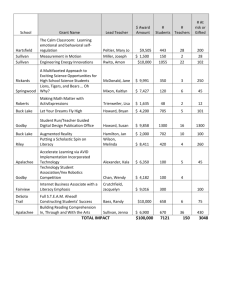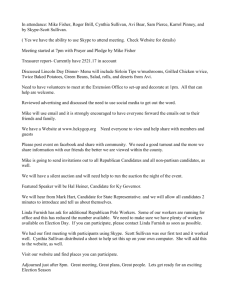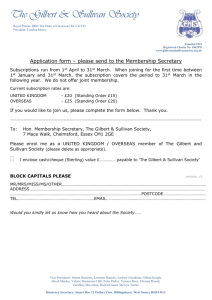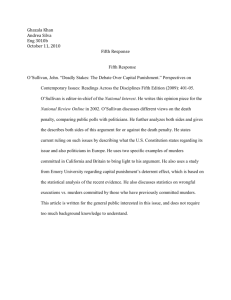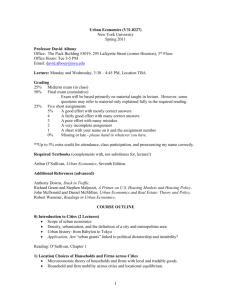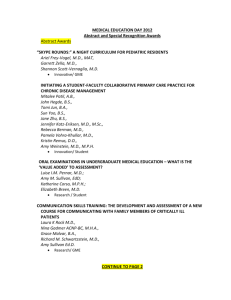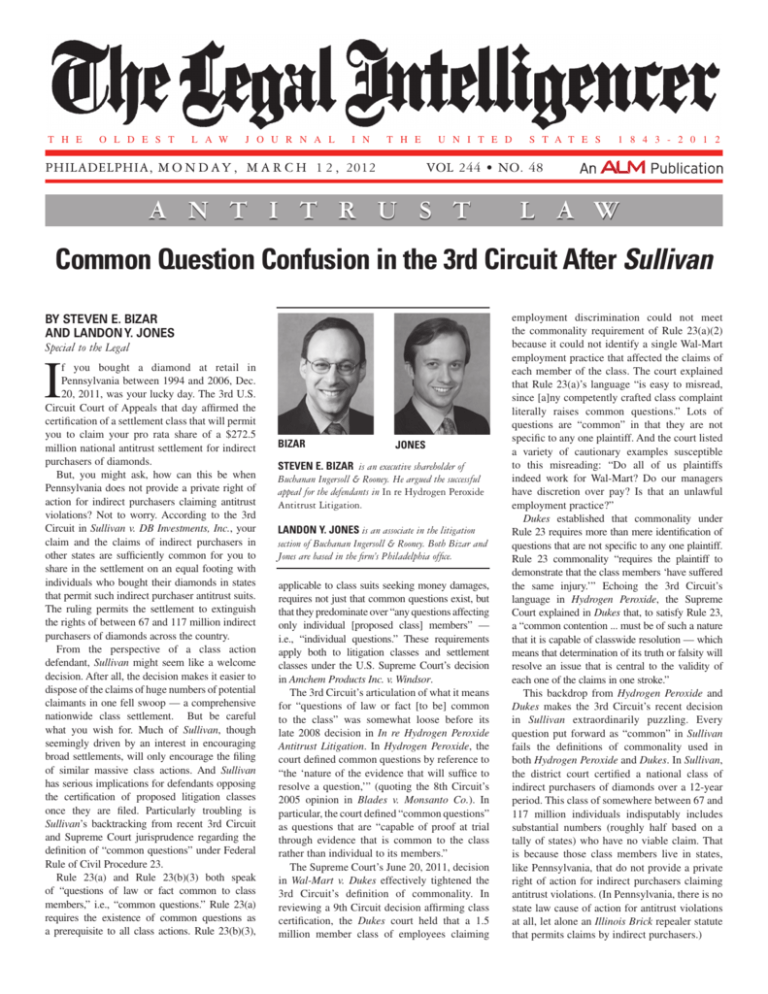
T h e
O l d e s t
L a w
J o u r n a l
i n
t h e
philadelphia, m o n d a Y , MA R C H 1 2 , 2012
U n i t e d
St a t e s
1 8 4 3 - 2 0 1 2
VOL 244 • NO. 48
a n t i t r u s t
l a w
Common Question Confusion in the 3rd Circuit After Sullivan
By Steven E. Bizar
and Landon Y. Jones
Special to the Legal
I
f you bought a diamond at retail in
Pennsylvania between 1994 and 2006, Dec.
20, 2011, was your lucky day. The 3rd U.S.
Circuit Court of Appeals that day affirmed the
certification of a settlement class that will permit
you to claim your pro rata share of a $272.5
million national antitrust settlement for indirect
purchasers of diamonds.
But, you might ask, how can this be when
Pennsylvania does not provide a private right of
action for indirect purchasers claiming antitrust
violations? Not to worry. According to the 3rd
Circuit in Sullivan v. DB Investments, Inc., your
claim and the claims of indirect purchasers in
other states are sufficiently common for you to
share in the settlement on an equal footing with
individuals who bought their diamonds in states
that permit such indirect purchaser antitrust suits.
The ruling permits the settlement to extinguish
the rights of between 67 and 117 million indirect
purchasers of diamonds across the country.
From the perspective of a class action
defendant, Sullivan might seem like a welcome
decision. After all, the decision makes it easier to
dispose of the claims of huge numbers of potential
claimants in one fell swoop — a comprehensive
nationwide class settlement. But be careful
what you wish for. Much of Sullivan, though
seemingly driven by an interest in encouraging
broad settlements, will only encourage the filing
of similar massive class actions. And Sullivan
has serious implications for defendants opposing
the certification of proposed litigation classes
once they are filed. Particularly troubling is
Sullivan’s backtracking from recent 3rd Circuit
and Supreme Court jurisprudence regarding the
definition of “common questions” under Federal
Rule of Civil Procedure 23.
Rule 23(a) and Rule 23(b)(3) both speak
of “questions of law or fact common to class
members,” i.e., “common questions.” Rule 23(a)
requires the existence of common questions as
a prerequisite to all class actions. Rule 23(b)(3),
bizar
jones
Steven E. Bizar is an executive shareholder of
Buchanan Ingersoll & Rooney. He argued the successful
appeal for the defendants in In re Hydrogen Peroxide
Antitrust Litigation.
Landon Y. Jones is an associate in the litigation
section of Buchanan Ingersoll & Rooney. Both Bizar and
Jones are based in the firm’s Philadelphia office.
applicable to class suits seeking money damages,
requires not just that common questions exist, but
that they predominate over “any questions affecting
only individual [proposed class] members” —
i.e., “individual questions.” These requirements
apply both to litigation classes and settlement
classes under the U.S. Supreme Court’s decision
in Amchem Products Inc. v. Windsor.
The 3rd Circuit’s articulation of what it means
for “questions of law or fact [to be] common
to the class” was somewhat loose before its
late 2008 decision in In re Hydrogen Peroxide
Antitrust Litigation. In Hydrogen Peroxide, the
court defined common questions by reference to
“the ‘nature of the evidence that will suffice to
resolve a question,’” (quoting the 8th Circuit’s
2005 opinion in Blades v. Monsanto Co.). In
particular, the court defined “common questions”
as questions that are “capable of proof at trial
through evidence that is common to the class
rather than individual to its members.”
The Supreme Court’s June 20, 2011, decision
in Wal-Mart v. Dukes effectively tightened the
3rd Circuit’s definition of commonality. In
reviewing a 9th Circuit decision affirming class
certification, the Dukes court held that a 1.5
million member class of employees claiming
employment discrimination could not meet
the commonality requirement of Rule 23(a)(2)
because it could not identify a single Wal-Mart
employment practice that affected the claims of
each member of the class. The court explained
that Rule 23(a)’s language “is easy to misread,
since [a]ny competently crafted class complaint
literally raises common questions.” Lots of
questions are “common” in that they are not
specific to any one plaintiff. And the court listed
a variety of cautionary examples susceptible
to this misreading: “Do all of us plaintiffs
indeed work for Wal-Mart? Do our managers
have discretion over pay? Is that an unlawful
employment practice?”
Dukes established that commonality under
Rule 23 requires more than mere identification of
questions that are not specific to any one plaintiff.
Rule 23 commonality “requires the plaintiff to
demonstrate that the class members ‘have suffered
the same injury.’” Echoing the 3rd Circuit’s
language in Hydrogen Peroxide, the Supreme
Court explained in Dukes that, to satisfy Rule 23,
a “common contention ... must be of such a nature
that it is capable of classwide resolution — which
means that determination of its truth or falsity will
resolve an issue that is central to the validity of
each one of the claims in one stroke.”
This backdrop from Hydrogen Peroxide and
Dukes makes the 3rd Circuit’s recent decision
in Sullivan extraordinarily puzzling. Every
question put forward as “common” in Sullivan
fails the definitions of commonality used in
both Hydrogen Peroxide and Dukes. In Sullivan,
the district court certified a national class of
indirect purchasers of diamonds over a 12-year
period. This class of somewhere between 67 and
117 million individuals indisputably includes
substantial numbers (roughly half based on a
tally of states) who have no viable claim. That
is because those class members live in states,
like Pennsylvania, that do not provide a private
right of action for indirect purchasers claiming
antitrust violations. (In Pennsylvania, there is no
state law cause of action for antitrust violations
at all, let alone an Illinois Brick repealer statute
that permits claims by indirect purchasers.)
As a result, the supposed “common questions”
on which the district court based certification
simply have no application to vast swaths of
the class. The “common questions” identified in
Sullivan were whether the defendants combined
or conspired, caused prices to be higher, or caused
injury to class members. Those questions are not
capable of proof at trial through evidence that is
“common” to the class because the evidence used
to answer the questions would be completely
irrelevant for much of the class. It cannot
seriously be said for any of those questions that
“determination of its truth or falsity will resolve
an issue that is central to the validity of each
one of the claims in one stroke.” (See Dukes.)
For example, “whether defendants combined or
conspired” is not plausibly “central” to the claim
of a Pennsylvania indirect purchaser because that
Pennsylvanian’s claim would be dead on arrival
if he or she were to bring an individual claim
in court. As Judge Kent A. Jordan explained in
dissent, “it is nonsense to speak of ‘resolving’ an
issue that is central to the validity of each one of
the claims” if all class members do not have at
least some colorable legal claim.
The Sullivan court’s result appears to have
been driven largely by an interest in encouraging
broad class action settlements when a case would
otherwise be too difficult to resolve. In that
respect, the Supreme Court’s earlier decision
in Amchem provided the Sullivan court with a
seemingly way out. Amchem does require courts
faced with motions to certify settlement classes
to apply virtually all of Rule 23 with all the
same rigor, if not more, than applied to litigation
classes. Indeed, the Amchem court suggested that
a court should apply “heightened” attention “to
protect absentees by blocking unwarranted or
overbroad class definitions.” However, Amchem
affords one exception: A district court “need
not inquire whether the case, if tried, would
present intractable management problems, for
the proposal is that there be no trial.”
Seizing on that exception, the Sullivan court
dodged an examination of the “nature of the
evidence” sufficient to resolve material common
questions. The court did this by characterizing
the inquiry, as it related to class members with
no viable claims at all, as a “merits” inquiry
“particularly unwarranted” for settlement
classes when “trial manageability” is not a
concern. (“The absence of evidentiary and trial
manageability concerns that initially motivated
our instruction to conduct a preliminary merits
inquiry in the predominance context reinforces
the ‘key’ distinction between certification of a
litigation and settlement class.”)
Judge Anthony J. Scirica, the author of the
Hydrogen Peroxide opinion, wrote a concurrence
in part to emphasize this point: “A key question
in a litigation class action is manageability —
how the case will or can be tried, and whether
there are questions of fact or law that are capable
of common proof. But the settlement class
presents no management problems because the
case will not be tried.”
Scirica, in fact, would define commonality
differently for a settlement class, using the standard
for supplemental jurisdiction of claims “deriving
from a common nucleus of operative fact.”
The Sullivan court’s effective relegation of
the “nature of the evidence” inquiry to a mere
“trial management” concern marks a substantial
departure from the Hydrogen Peroxide court’s clear
statement that “the nature of the evidence that will
suffice to resolve a question determines whether
the question is common or individual” (quoting
Blades). In other words, in Hydrogen Peroxide,
Particularly troubling is
Sullivan’s backtracking
from recent 3rd Circuit and
Supreme Court jurisprudence
regarding the definition of
‘common questions.’
whether antitrust impact was “capable of proof at
trial through evidence common to the class” was
debated because it answered whether antitrust
impact was itself a “common question” that could
support a determination of predominance. But
the Sullivan court discusses the “nature of the
evidence” as if it were only relevant to questions
regarding trial management, in conflict with Dukes
and Hydrogen Peroxide, among others.
The Sullivan court instead bases its
predominance holding on earlier 3rd Circuit
precedent purportedly focusing “on whether
the defendant’s conduct was common as to all
of the class members, and whether all of the
class members were harmed by the defendant’s
conduct.” But even accepting the premise that
“all of the class members were harmed” by the
defendants’ conduct in some abstract sense,
this too is in conflict with Dukes. Dukes goes
out of its way to explain that a myopic focus
on “defendant’s conduct” is irrelevant without
taking account of how that conduct relates to the
legal claims of each class member. Under Dukes,
if each class member’s claim depends upon a
“common contention” regarding defendant’s
conduct and resolving that contention “will
resolve an issue that is central to the validity
of each one of the claims in one stroke,” then
the issue may fairly be said to be “common”
under Rule 23. But in Sullivan, the claims of
Pennsylvanians and other indirect purchasers do
not “depend” on the conduct of the defendants,
as the Sullivan court assumes, because they
have no claims at all under the applicable state
law. As Jordan explained in his dissent, it is
unprecedented for a court to rule that, in deciding
commonality, “one need not be concerned with
whether the alleged injuries of class members are
legally cognizable.”
The Sullivan court also characterizes the
requirement in some states that a plaintiff be
a direct purchaser as “simply another element
of proof for an antitrust claim.” It is perhaps
a metaphysical question whether an indirect
purchaser in states prohibiting indirect purchaser
suits lacks the ability to prove “one element” of
his claim or whether he lacks a claim at all. (In
Pennsylvania, the latter certainly seems a better
description.) But as Jordan explained in dissent,
“the status of being an indirect purchaser is not
only the gateway to membership in the class, it is
what entirely disqualifies them from asserting any
claim based on De Beer’s price fixing conduct.”
This inherent deficiency precludes commonality
because no questions can be “central to the
validity” of their claims. (See Dukes.)
There is no doubt that it would be extremely
burdensome for a court to engage in careful
inquiry into the laws of all 50 states when
presented with a motion to certify a nationwide
settlement class for claims brought under
state laws, some of which are pointed out
indisputably to lack viability. This is not “factfinding review” as the en banc Sullivan court
curiously characterizes the inquiry. It is merely
the court’s bread-and-butter task of saying “what
the law is.” But it is hard work. The conclusion
to draw is not, as the Sullivan court implies, that
because such an “intensive cataloging” might
effectively preclude nationwide settlements, it
must not be required. It should be difficult
— maybe even preclusively difficult — to
settle the varied rights of one-third of the
country’s population in a single proceeding,
as happened in Sullivan. These are courts, not
legislatures. The predominance inquiry under
Rule 23 is about “the legal or factual questions
that qualify each class member’s case as a
genuine controversy.” (See Amchem.) It is not
too much to ask of a court to ensure that such
a “genuine controversy” exists, and that the
rights of millions who have such a “genuine
controversy” are not diluted by the nonexistent
“rights” of others who clearly do not.
•
Reprinted with permission from the March 12, 2012 edition
of The Legal Intelligencer © 2012 ALM Media
Properties, LLC. All rights reserved. Further duplication
without permission is prohibited. For information, contact
347-227-3382, reprints@alm.com or visit www.almreprints.
com. # 201-03-12-07



